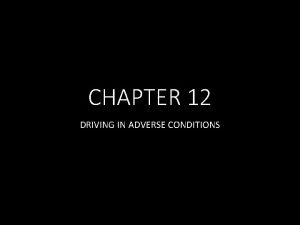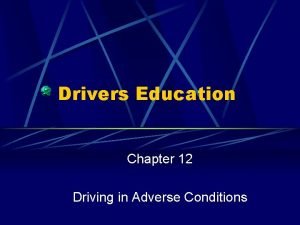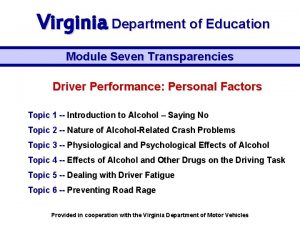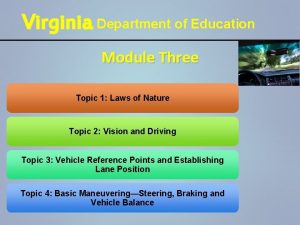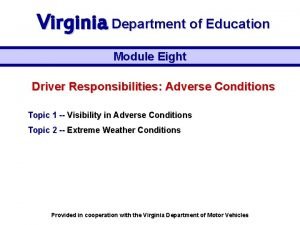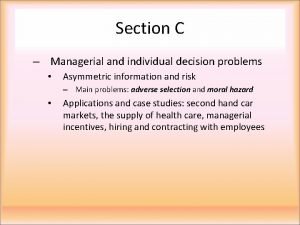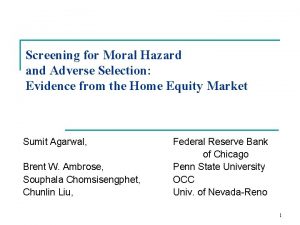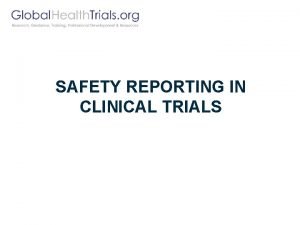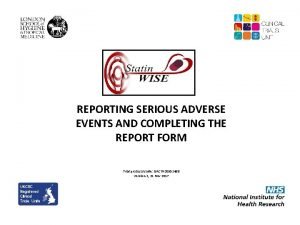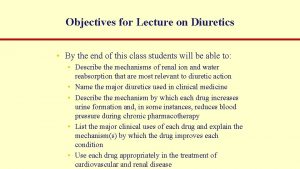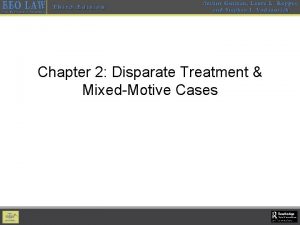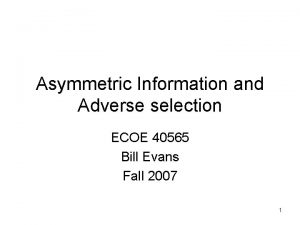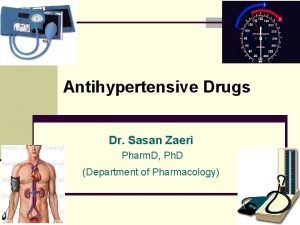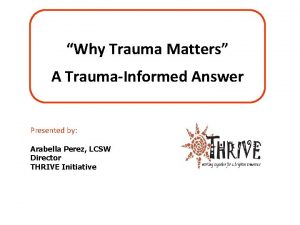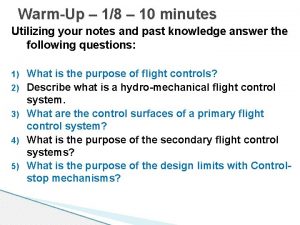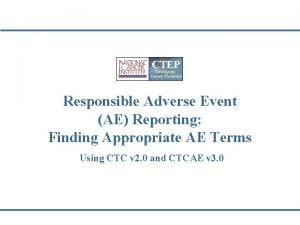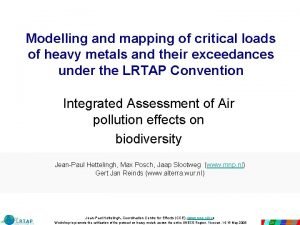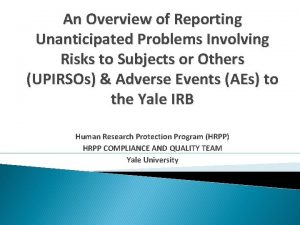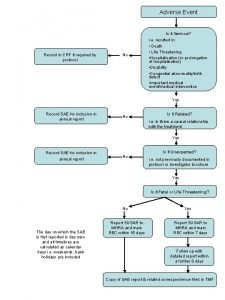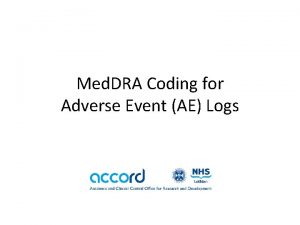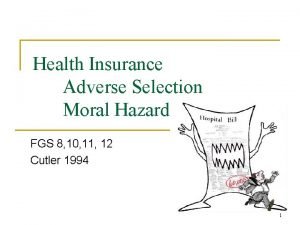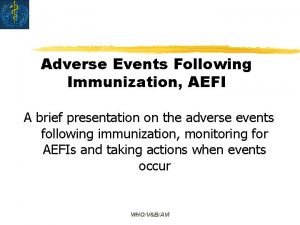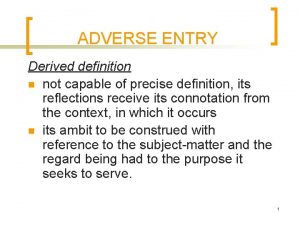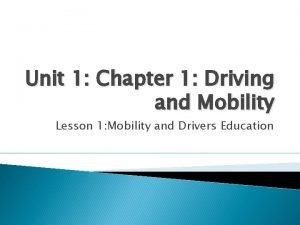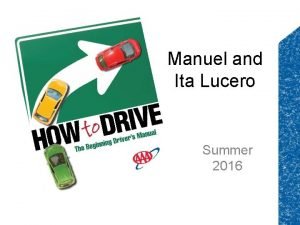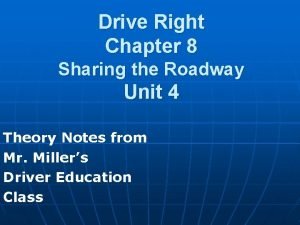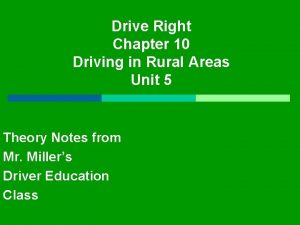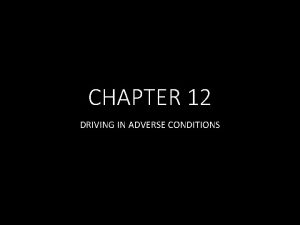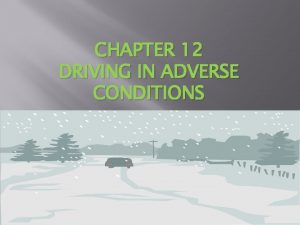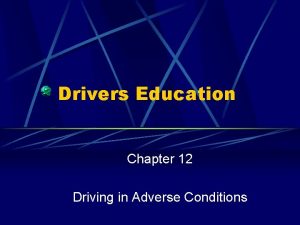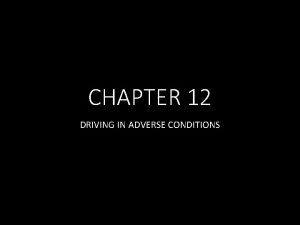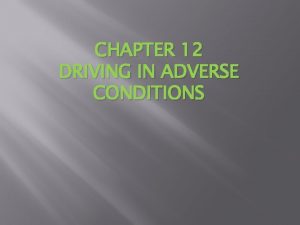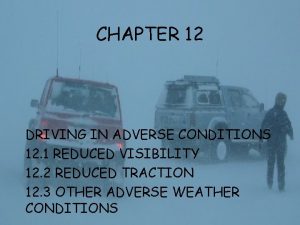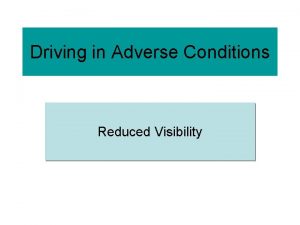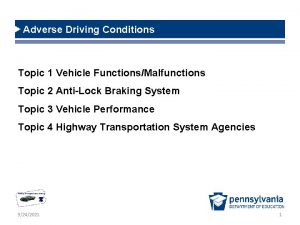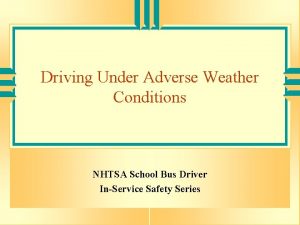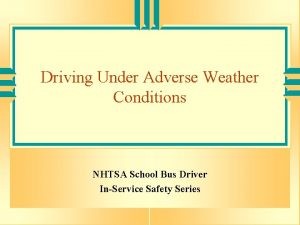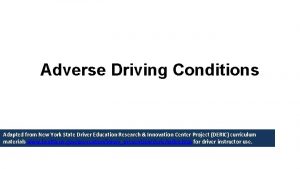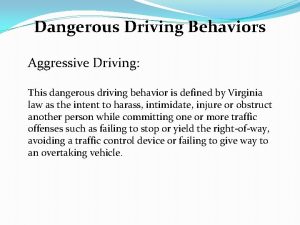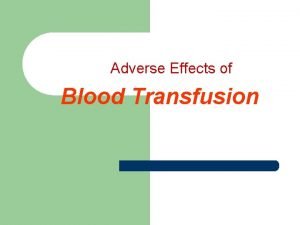Module 9 Adverse Conditions Chapter 12 Driving in


































































- Slides: 66

Module 9 Adverse Conditions

Chapter 12 Driving in Adverse Conditions �Why is it important to be well informed and prepared for a variety of adverse road and weather conditions prior to driving anywhere? �What are the risks associated with being unprepared?

Chapter 12 Driving in Adverse Conditions �If you were the driver in this reduced visibility and traction situation, what precautions would you take?

Chapter 12 Driving in Adverse Conditions �KEY IDEA What can you do to manage the effects of hazardous weather on your visibility and your vehicle’s traction?

Chapter 12 Driving in Adverse Conditions �IPDE Whenever visibility is reduced, drivers need more time to use the IPDE Process and apply Zone Control driving techniques. You can maintain a safe intended path of travel by doing the following: 1. Slowing down to give yourself more time 2. Scanning in and around your path of travel to the target area. 3. Deciding to position your vehicle ahead of time with an extra space cushion around it. 4. Executing driving actions gently to maintain control so others know what you are doing.

IPDE Process (Identify, Predict, Decide & Execute) �Identify important information in the current driving situation �Predict when and where possible points of conflict may develop �Decide when, where, and how to communicate, adjust speed, and/or change position to avoid conflict. �Execute the correct action(s) to prevent conflict.

Zones Right Front Zone Left Front Zone Right Rear Zone Left Rear Zone

Zones �An open zone is space where you can drive without a restriction to your line of sight or to your intended path of travel. �A closed zone is a space not open to you because of a restriction in your line of sight or intended path of travel such as a red traffic light.

Chapter 12 Driving in Adverse Conditions Weather/Driving Situation Driving Tips

Chapter 12 Driving in Adverse Conditions �Dirty Windows

Chapter 12 Driving in Adverse Conditions 1. Dirty Windows It is important to keep your windows clean because dirty windows will reduce your visibility. Clean all windows and lights ahead of time in bad weather. Keep a close check on any ice, snow, or dirt buildup, especially on headlights and taillights. Stop to clean them by hand.

Chapter 12 Driving in Adverse Conditions �Moisture on your windshield

Chapter 12 Driving in Adverse Conditions 2. Moisture � A simple thing like moisture forming on the inside of your windshield can make the difference between safe, low-risk driving and colliding with another vehicle. � When the slightest amount of moisture builds up, turn on your front-window defroster, switch on your rear defogger, or use the air conditioner or heater if it will help you. You can always open windows as needed.

Chapter 12 Driving in Adverse Conditions �Even in good weather, clean windows can be a problem. The plastics used in many vehicle interiors can give off vapors that coat the inside of windows over time. By keeping windows clear, you improve your ability to indentify, especially at night.

Chapter 12 Driving in Adverse Conditions �Sun Glare

Chapter 12 Driving in Adverse Conditions 3. Sun Glare At times, the sun can create severe and blinding glare conditions. Sunglasses and visors can help, but try to avoid looking toward the sun. *By driving with low-beam headlights on all the time, you help other drivers see you.

Chapter 12 Driving in Adverse Conditions By driving with low-beam headlights on all the time, you help other drivers see you. ▪ The brightest day will create the darkest shadows. ▪ With severe-glare situations and the sun behind you, be prepared for other drivers to miss seeing your signal or even seeing you vehicle

Chapter 12 Driving in Adverse Conditions �Low Levels of Light

Chapter 12 Driving in Adverse Conditions 4. Low Levels of Light Low levels of light at night severely limit your ability to use the IPDE Process. Dawn and dusk-driving situations can also be very dangerous. The low visual contrast between moving vehicles and the driving scene can be deceiving. By always driving with your headlights on lowbeam, you can help others to see you.

Chapter 12 Driving in Adverse Conditions �Headlights Keep these points in mind when driving with your headlights on at night: Use high-beam headlights to see further down the road. ▪ Only use your high-beam headlights when vehicles are more than one-half mile in front of you. Use low-beam headlights in bad weather. In snow, heavy rain, or fog, high beam headlights will reflect more light back into your eyes; as a result, you will see less.

Chapter 12 Driving in Adverse Conditions �Meeting Other Vehicles with High Beams

Chapter 12 Driving in Adverse Conditions 5. Meeting Other Vehicles If an oncoming driver has high-beam headlights on, take the appropriate action based on the following questions: 1. Is the oncoming driver far enough away to respond to you? If so, briefly flash your lights 2. Is the oncoming driver closer, and still using high-beam headlights? Slow down, move to the right, and glance at the right edge of the road.

Chapter 12 Driving in Adverse Conditions �Overdriving Headlights The term overdriving headlights means driving at a speed that makes your stopping distance longer than the distance lighted by your headlights. Do not overdrive your headlights, especially in bad weather or on a slick road. ▪ Remember the 4 -second stopping-distance rule

Chapter 12 Driving in Adverse Conditions �Visibility and Weather

Chapter 12 Driving in Adverse Conditions �Visibility and Weather Adverse weather can increase the risk of being unable to see your surroundings and being seen by other drivers. The best way to reduce the level of risk is to postpone driving until the weather clears. If you must drive in fog, rain, or snow, remember that with reduced visibility comes an increased level of risk.

Chapter 12 Driving in Adverse Conditions �FOG

Chapter 12 Driving in Adverse Conditions 6. Fog Always use low-beam headlights in fog. Fog reduces your ability to judge driving distances. Oncoming vehicles may be closer than you think. Avoid trouble by slowing down and increasing your following distance. Thick fog, even heavy industrial smoke can be very dangerous. Before entering fog or heavy smoke, be prepared to slow or stop safely off the side of the road. ▪ If you stop on the side of the roadway, use your hazard lights to warn others that you are stopped. To be even safer, park in a rest area or parking lot if possible.

Chapter 12 Driving in Adverse Conditions �Rain

Chapter 12 Driving in Adverse Conditions 7. Rain Heavy rain reduces your ability to see and be seen. Keep your windshield clear by using your wipers and your defroster on if your windows fog. Make sure your low-beam headlights are on. Reduce your speed. ▪ If the rain is so heavy that you cannot see well, be prepared to pull off the road and sit out the storm in a safe location, using your hazard flashers.

Chapter 12 Driving in Adverse Conditions �Snow

Chapter 12 Driving in Adverse Conditions 8. Snow Wind-driven snow can reduce your vision, cover roadway markings, and make steering more difficult. Be prepared to slow and steer carefully. Heavy snow can block your rear window, reducing visibility. Slush or ice can also build up on your windshield wipers. If this happens, pull off the road and clean off your windshield, headlights, taillights and other parts of your car as needed. Use low-beam headlights when it snows day or night. Reduce your speed to maintain control and to give others time to respond to you.

Chapter 12 Driving in Adverse Conditions �Snow If snow covers the road, closing your right front zone, do not crowd the center of the road because it has the effect of narrowing the road and could lead to a head-on collision. The best way to stay safe is to delay your travel.

Chapter 12 Driving in Adverse Conditions �Other Reduced-Traction Situations

Chapter 12 Driving in Adverse Conditions �Wet Roadways

Chapter 12 Driving in Adverse Conditions 9. Wet Roadways Traction allows your tires to grip the roadway so you can control your vehicle. Rain, snow, ice, sand, and other materials can limit your traction. Reduced traction can create high-risk driving situations. Reduce your speed on wet roadways

Chapter 12 Driving in Adverse Conditions �Hydroplaning

Chapter 12 Driving in Adverse Conditions 10. Hydroplaning When a tire loses road contact by rising up on top of water and no longer has contact with the road, hydroplaning occurs. Hydroplaning is caused by a combination of standing water, speed, and tire condition. If your car hydroplanes, stay calm, take your foot off the accelerator, and steer carefully. Even with good tires, hydroplaning can occur at speeds of 35 mph, in water as little as 1/12 an inch deep. ▪ Slush and snow increase the risk of hydroplaning.

Chapter 12 Driving in Adverse Conditions �Deep Water

Chapter 12 Driving in Adverse Conditions 11. Deep Water/Floods �Floods cause more deaths than any other weather condition, and 60% are vehicle related. �Deep Water If you do not know the depth of the water ahead, do not drive through it.

Chapter 12 Driving in Adverse Conditions �Ice

Chapter 12 Driving in Adverse Conditions 12. Ice Be especially alert if temperatures drop below freezing and it’s raining. These conditions are perfect for snow, ice, and sleet. ▪ Predict the worst when ice begins to form. 1. 2. 3. 4. 5. Decrease your speed and leave yourself plenty of room to stop. Brake gently to avoid skidding. Turn on your lights to increase your visibility to other motorists. Keep your lights and windshield clean. Use low gears to keep traction, especially on hills.

Chapter 12 Driving in Adverse Conditions �Ice on Bridges

Chapter 12 Driving in Adverse Conditions �Ice on Bridges Bridge roadways tend to freeze before other roadway surface. Cold air circulates above and below the roadway on bridges and overpasses.

Chapter 12 Driving in Adverse Conditions �Black Ice

Chapter 12 Driving in Adverse Conditions �Black Ice Be alert for “black ice” that forms in thin sheets, which can be extremely hard to see. ▪ Be extra careful for this type of ice in winter mountain situations.

Chapter 12 Driving in Adverse Conditions �Ice in Tire Tracks

Chapter 12 Driving in Adverse Conditions 13. Ice in Tire Tracks Snow can pack down into ice in the normal driving tracks, especially at intersections. Avoid these slippery tracks by moving a little to the right to use the unpacked, less-slick portion of your lane.

Chapter 12 Driving in Adverse Conditions �Gravel Roads

Chapter 12 Driving in Adverse Conditions 14. Gravel Roads Loose gravel on roads can act like marbles under your tires and cause skids. Well-packed wheel paths usually form in gravel roads. Drive in these paths for better traction and control. ▪ If you need to move out of the wheel paths, slow down and hold your steering wheel firmly.

Chapter 12 Driving in Adverse Conditions �Construction Areas

Chapter 12 Driving in Adverse Conditions 15. Construction Areas Construction trucks or other equipment can leave mud, dirt, or sand on the road. Slow, steer gently, and obey workers’ directions. Be especially careful for workers and construction drivers who do not see you. ▪ Increase your following distance. *Traffic fines double in construction zones.

Chapter 12 Driving in Adverse Conditions �Skidding

Chapter 12 Driving in Adverse Conditions 16. Skidding In extreme reduced-traction situations, your tires may loose all or part of their grip on the road and skid. Skidding can happen on any surface while you are braking, accelerating, or steering. In addition to slowing ahead of time, early detection is one of your best defenses to control skidding. 1. Look where you want to go, and not at what you might run into. 2. Point your front tires where you want to go. Or, as you may have heard, steer in the direction of the skid. And don't overcompensate. Simply put: look where you want to go and then point the tires in that direction.

Chapter 12 Driving in Adverse Conditions �Wind

Chapter 12 Driving in Adverse Conditions 17. Wind Strong winds can reduce your vehicle control and push lightweight vehicles out of the lane or even off the road. Remember to keep a balanced grip on the steering wheel and be ready to make steering corrections for crosswinds. Sometimes a passing truck can produce a strong blast of wind. To maintain control, be prepared to slow a little and apply extra steering to keep moving in your intended path of travel If you are in an area where tornadoes are spotted, be ready to act. ▪ Find the lowest lying area like ditch.

Chapter 12 Driving in Adverse Conditions �Hot Weather

Chapter 12 Driving in Adverse Conditions 18. Hot Weather Your vehicle is designed to operate in a wide range of temperatures. But in extreme cases, problems can develop. Your temperature light or gauge indicates when your engine is too hot. It might be uncomfortable, but you might be able to cool your engine by turning on your heater. If the engine temperature warning light stays on, stop and park in a safe place to let your engine cool.

Chapter 12 Driving in Adverse Conditions �Skidding The instant you see your vehicle is not traveling in your intended path of travel toward your target, you need to start correcting the skid. If you wait until you feel your vehicle skidding, you may not be able to correct the skid in time to avoid trouble.

Chapter 12 Driving in Adverse Conditions �Loss of Traction In all loss-of-traction situations, remember that locked or spinning wheels provide no traction or steering control.

Chapter 12 Driving in Adverse Conditions �Loss of Traction to Power Wheels You are at a stop sign and the road is slippery with hard packed snow and ice. As you accelerate to pull away from your stopped position, you notice your power wheels are spinning. ▪ What should you do?

Chapter 12 Driving in Adverse Conditions �In this situation simply release your accelerator and allow the spinning tires to stop spinning and regain traction.

Chapter 12 Driving in Adverse Conditions �Activity Step 1 Make a list of 10 items that would help you in any adverse driving situation

Chapter 12 Driving in Adverse Conditions �Activity Step 2 Compare your list to your table mates. Make a list of the items you both had on the list.

Chapter 12 Driving in Adverse Conditions �Activity Step 3 Select the most important item you think you should always carry in your car. You cannot pick your cell phone.

Chapter 12 Driving in Adverse Conditions �Using the textbook or your notes, define the following key terms: 1. 2. 3. Overdriving Headlights Hydroplaning Skid

Journal Topic �Write a paragraph on the following topic: What is the most common adverse driving condition you will encounter when driving in Texas? What steps can you take to be prepared to handle this situation.
 To give yourself more time for the i pde process at night
To give yourself more time for the i pde process at night 5.2 driving in adverse conditions assignment
5.2 driving in adverse conditions assignment Chapter 12 driving in adverse conditions
Chapter 12 driving in adverse conditions When your headlights shine into fog, *
When your headlights shine into fog, * 6 driving conditions
6 driving conditions Module 7 topic 5-6 drivers ed
Module 7 topic 5-6 drivers ed Module 3 topic 1
Module 3 topic 1 Driving module
Driving module Allows maximum stopping force without locking up the brakes
Allows maximum stopping force without locking up the brakes Module 7 topic 1 distracted driving
Module 7 topic 1 distracted driving C device module module 1
C device module module 1 Adverse reaction definition
Adverse reaction definition Sentinel adverse event
Sentinel adverse event Adverse selection
Adverse selection Adverse selection
Adverse selection Adverse reaction definition
Adverse reaction definition Adverse reaction definition
Adverse reaction definition Adverse events in hospital
Adverse events in hospital Ir adverse event
Ir adverse event Puerperal sepsis
Puerperal sepsis What is adverse selection
What is adverse selection Effects of paracetamol
Effects of paracetamol Loop diuretics adverse effects
Loop diuretics adverse effects Mechanism of action of acetaminophen
Mechanism of action of acetaminophen Tradjenta to januvia conversion
Tradjenta to januvia conversion Adverse selection
Adverse selection Adr adverse drug reaction
Adr adverse drug reaction Loop diuretics adverse effects
Loop diuretics adverse effects Mannitol mechanism of action
Mannitol mechanism of action Hayanil side effects
Hayanil side effects Adverse treatment
Adverse treatment Adverse selection
Adverse selection Adverse event adalah
Adverse event adalah Drugs that don't cross placenta mnemonic
Drugs that don't cross placenta mnemonic Adverse effect of alpha blockers
Adverse effect of alpha blockers Beta blockers moa
Beta blockers moa Adverse effect of alpha blockers
Adverse effect of alpha blockers Alpha-adrenergic antagonist
Alpha-adrenergic antagonist Adverse childhood experiences study
Adverse childhood experiences study Adverse yaw
Adverse yaw Adverse childhood experiences study
Adverse childhood experiences study Adverse event
Adverse event Novartis adverse event reporting
Novartis adverse event reporting Mhmr of tarrant county
Mhmr of tarrant county Adverse
Adverse Adverse yaw
Adverse yaw Unanticipated problem vs adverse event
Unanticipated problem vs adverse event Adverse event crf
Adverse event crf Adverse childhood experiences powerpoint
Adverse childhood experiences powerpoint Slidetodoc.com
Slidetodoc.com Adverse selection
Adverse selection Adverse event log
Adverse event log What is adverse selection
What is adverse selection Definition of adverse event
Definition of adverse event Tools to help solve adverse selection problems
Tools to help solve adverse selection problems Serious adverse event reconciliation
Serious adverse event reconciliation Adverse food reactions
Adverse food reactions Adverse events following immunization (aefi) course answers
Adverse events following immunization (aefi) course answers No adverse remarks meaning
No adverse remarks meaning Ahca adverse incident reporting
Ahca adverse incident reporting Crash costs are measured in dollars and in
Crash costs are measured in dollars and in Chapter 1 managing risk when driving
Chapter 1 managing risk when driving Cross traffic is eliminated on controlled access expressway
Cross traffic is eliminated on controlled access expressway While driving in urban situations
While driving in urban situations Inhibitions drivers ed
Inhibitions drivers ed A closing probability when driving is chapter 8
A closing probability when driving is chapter 8 Traffic controls help you to travel safely by *
Traffic controls help you to travel safely by *
